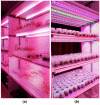Effect of LED Lighting on Physical Environment and Microenvironment on In Vitro Plant Growth and Morphogenesis: The Need to Standardize Lighting Conditions and Their Description
- PMID: 35009064
- PMCID: PMC8747321
- DOI: 10.3390/plants11010060
Effect of LED Lighting on Physical Environment and Microenvironment on In Vitro Plant Growth and Morphogenesis: The Need to Standardize Lighting Conditions and Their Description
Abstract
In the last decades, lighting installations in plant tissue culture have generally been renewed or designed based on LED technology. Thanks to this, many different light quality advances are available but, with their massive implementation, the same issue is occurring as in the 1960s with the appearance of the Grolux (Sylvania) fluorescent tubes: there is a lack of a methodological standardization of lighting. This review analyzes the main parameters and variables that must be taken into account in the design of LED-based systems, and how these need to be described and quantified in order to homogenize and standardize the experimental conditions to obtain reproducible and comparable results and conclusions. We have designed an experimental system in which the values of the physical environment and microenvironment conditions and the behavior of plant tissue cultures maintained in cabins illuminated with two lighting designs can be compared. Grolux tubes are compared with a combination of monochromatic LED lamps calibrated to provide a spectral emission, and light irradiance values similar to those generated by the previous discharge lamps, achieving in both cases wide uniformity of radiation conditions on the shelves of the culture cabins. This study can help to understand whether it is possible to use LEDs as one standard lighting source in plant tissue culture without affecting the development of the cultures maintained with the previously regulated protocols in the different laboratories. Finally, the results presented from this caparison indicate how temperature is one of the main factors that is affected by the chosen light source.
Keywords: Grolux fluorescent lamps; in vitro culture; in vitro environmental conditions; light spectral characterization; light-emitting diodes (LEDs); plant tissue culture; temperature.
Conflict of interest statement
The authors declare no conflict of interest.
Figures







References
-
- Thomson G. The Museum Environment. 2nd ed. Elsevier Science; Burlington, VT, USA: 2013. - DOI
-
- Ahmed S., Amir F., Riaz-ul-Hasnain S., Shahwar D., Jamil S. Electronic ballast circuit configurations for fluorescent lamps; Proceedings of the 2015 Power Generation System and Renewable Energy Technologies (PGSRET); Islamabad, Pakistan. 10–11 June 2015; pp. 1–8. - DOI
-
- Hammer E.E. Effects of ambient temperature on the performance of bent tube fluorescent lamps. IEEE Trans. Ind. Appl. 1989;25:216–223. doi: 10.1109/28.25534. - DOI
-
- Helson V.A. Comparison of Gro-Lux and cool-white fluorescent lamps with and without incandescent as light sources used in plant growth rooms for growth and development of tomato plants. Can. J. Plant Sci. 1965;45:461–466. doi: 10.4141/cjps65-089. - DOI
Publication types
Grants and funding
LinkOut - more resources
Full Text Sources

